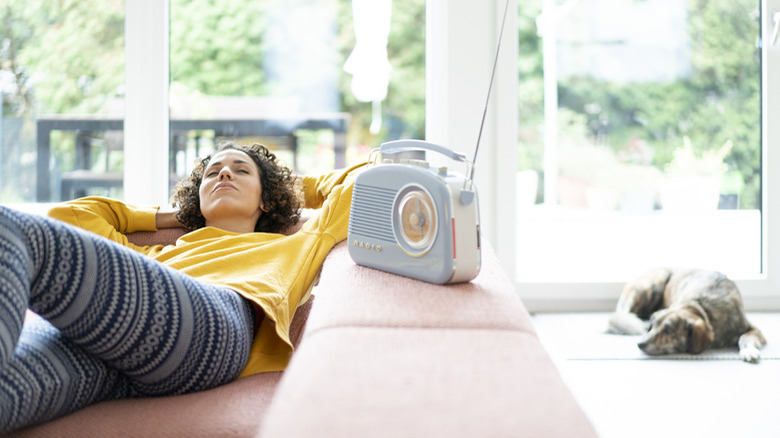Sounds That Are Painful For Dogs
Although it's common knowledge that dog's noses are super-sniffers used for detecting drugs, medical conditions, and explosives, it's easy to overlook their other sensitive senses, like hearing. "The truth of the matter is that, for some sounds, a dog's hearing is really hundreds of times better than ours, whereas for other sounds, dogs and humans have sound sensitivities that are very much the same," Stanley Coren, Ph.D, explained in his book "How Dogs Think" (via the American Kennel Club). Given this, it may not come as a surprise that some noises can hurt your canine's ears.
What to know about dog hearing
There's a good reason why dogs have such acute hearing. While human ears evolved to be able to hear sounds between 64 and 23,000 Hertz (Hz), a dog can listen to between 67 and 45,000 Hz, according to Louisiana State University. That puts much of their hearing at high frequencies outside the range of human perception.
Hertz is how a sound's frequency is measured. The higher the Hz, the higher the frequency. A dog's ears evolved to tune in to high-pitched sounds of their prey, according to the AKC. Their ears can detect the high-pitched squeak of a mouse venturing out of its den, for example.
They can also hear much softer sounds than humans can. While a young human can listen to sounds at 0 decibels (dB) — the measure of intensity or loudness of a sound — dogs can hear low sounds at -5 to 15 dB per the AKC.
It might seem that your dog is psychic and knows when your spouse is returning home from work minutes before they pull into the driveway. However, they're probably hearing a high-pitched engine sound from a few blocks away or the low hum of the engine long before it enters your range of hearing.
Understand sounds dogs hate
Does your dog scurry off into the backroom whenever you rev up the vacuum cleaner? High-pitched noises from the motor that humans can't perceive is probably the issue. This makes it pointless to force your dog to be in the room, hoping he'll get used to it.
Audio frequencies that hurt a dog's ears can be damaging as well as uncomfortable, according to Psychology Today. Hearing loss in hunting dogs from being close to the sound of gunfire without ear protection has been well-documented since a 2002 study by the University of Mississippi.
Other sounds that can be uncomfortable for dogs' acute hearing includes
- Thunder
- Fireworks
- Power tools
- Sirens
- Jingling keys or dog tags
- Loud music such as at an outdoor rock concert or enclosed car or room
- Other dogs barking in an enclosed environment such as a kennel
Watch for signs of sensitivity
Your dog will display symptoms that an audio frequency is hurtful to his ears. Pinning the ears close to the head to shut out the sound or attempting to leave the sound-stressful environment are some of the most basic signs that your dog's not comfortable.
Other tell-tale signs cited by the University of Illinois at Urbana-Champaign College of Veterinary Medicine include
- Quivering, shaking or trembling
- Whining
- Crawling in your lap or following you closely
- Drooling
- Restlessness or pacing
- Barking
- Hypervigilance
- Trying to escape
Don't punish your dog or yell at him if he reacts to a loud sound. This will only reinforce his anxiety and may escalate his response to aggression. Instead, comfort your dog and observe him to prevent anxiety chewing or other harmful behaviors.
Create a haven, such as putting them in an interior room with their favorite cushions, toys, and blankets. A den-like space such as a crate or under a table or bed is preferable. For extreme anxiety, consult your veterinarian to see if a medication can be helpful for your pet, advises the University of Illinois.
Put ultrasonic sounds to work
Ultrasonic training products use high-pitched sounds above the range of human hearing to deter unwanted behavior in dogs, such as barking or staying in the yard. The devices use an anti-dog sound frequency to works in a variety of ways according to Karma Pets.
Some products involve a dog wearing a collar that interacts with barrier systems that emit a high-pitched sound when a dog comes within a specific range. This can be useful for helping your dog to stay in the yard, out of the vegetable garden, or off the couch.
Other ultrasonic training devices detect a dog's bark and feed back an unpleasant high-pitched sound that interrupts his barking. Free-standing units allow a dog to leave a specific area to escape the noise, while units installed on a collar follow the dog wherever he goes.
Consider the dog
Although humans can't hear the sound, the deterrent training devices use frequencies aversive to dogs. The anti-barking tools don't discriminate between appropriate barking, such as when an intruder is trying to break in the window, or nuisance barking at the front door after you leave.
This could encourage your dog to become either helpless or aggressive, according to Psychology Today. Eventually, the dog can become used to the noise and continue the unwanted behavior anyway, enduring unnecessary stress and anxiety in the meantime.
Consider the effect on your dog of using ultrasonic devices around your home, including things like electronic rodent repellents, advises Pest Control FAQ. A 1995 study on rodent repellent devices by the University of Nebraska shows that reactions shown by mice to ultrasonic stimuli can include an initial startle, followed by aimless running and sometimes convulsions or death. The study notes that the same response occurs in dogs as well as rabbits, chickens, and goats.
